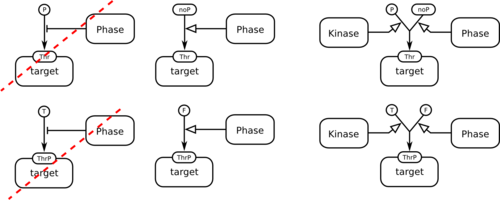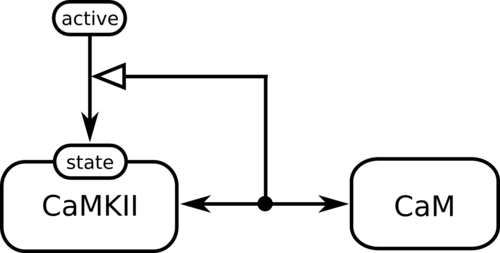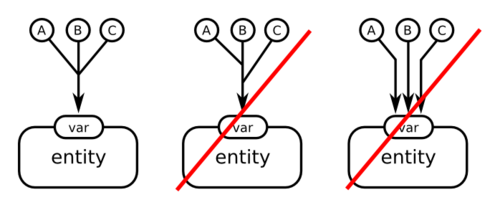
WHAT IS SBGN
SPECIFICATIONS
SOFTWARE
EVENTS
FAQ
HOW TO CITE
ABOUT
CONTACT
Learning SBGN
Examples
Reference Cards
Published Maps
Symbol Highlights
Figure to SBGN
Competition
Development Wiki
Entity Relationship FAQs
- How should I represent dephosphorylation?
- How can I represent that an interaction activates an interactor?
- How to represent assignment of different values to a variable?
- Can I represent modified and non-modified entities?
How should I represent dephosphorylation?
Dephosphorylation is the removal of a phosphate group attached to another molecule, such as a protein or a lipid. This dephosphorylation is often catalysed by a phosphatase. Representing dephosphorylation may be a challenge in a map where phosphorylations are also represented. The left drawings are misleadings. On the top, the value P is assigned to the variable “threonine” and dephosphorylation is different from the inhibition of the phosphorylation. But it is true that a probabilistic interpretation of the map would probably consider that as a lowering of the probability to be phosphorylated. A solution is to create another value for it, noP, which assignment is stimulated by the phosphatase. On the right the situation with both phosphorylation and dephosphorylation are represented. An alternative representation is to explicitly turned the map into a boolean logic model, with variable true and false assigned to the variable “phosphorylated on threonine”.

How can I represent that an interaction activates an interactor?
It is often the case that a protein is activated by the binding of another entity. In order to represent this in SBGN ER, we create an interaction between the two entities (Calmodulin - CaM - and CaMKII in the example). To represent the activation of the protein, we create a state variable “state”, and assign a value “active” to it. We then create an outcome of the interaction (its realisation), that stimulate the assignment.

How to represent assignment of different values to a variable?
A variable can only have one value at a time, therefore only one assignment arc connect to the state variable glyph. All arcs linking values to this arc should meet in one point, where there is an implicit XOR.

Can I represent modified and non-modified entities?
Yes. In some cases, it may be necessary to represent explicitly a modified entity rather than implicitly through a state variable representing the modification. The example below represents on the left the effect of a kinase on the existence of a phosphorylated and non-phosphorylated protein. On the right, the more classical view of a phosphorylation as a variable assignment. Both representation are correct, and unambiguous. However, the left representation does not relate the two entities prot-P and prot-nP and is therefore less precise.
